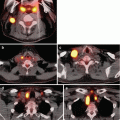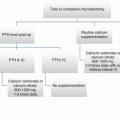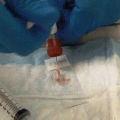© Springer International Publishing Switzerland 2017
Sanziana A. Roman, Julie Ann Sosa and Carmen C. Solórzano (eds.)Management of Thyroid Nodules and Differentiated Thyroid Cancer10.1007/978-3-319-43618-0_77. Surveillance of Benign Thyroid Nodules
(1)
Section of Endocrinology and Metabolism, Yale School of Medicine, New Haven, CT, USA
Keywords
Thyroid noduleThyroid cancerFine needle aspiration biopsySurveillanceMolecular markersFalse negativeLarge nodulesUltrasoundCytopathologyBenignIntroduction
This chapter will address current controversial issues in the management of cytologically benign thyroid nodules. Optimal follow-up of benign thyroid nodules is an area of debate. It is well known that a subset of cytologically benign thyroid nodules grow over time; however, growth often can be perceived as a sign of concern. Identification of growing nodules for rebiopsy is an area of interest. Fine needle aspiration (FNA) of thyroid nodules is associated with an error rate of approximately 5 %. Whether rebiopsy of cytologically benign thyroid nodules will improve the accuracy of the diagnosis is controversial. Management of large thyroid nodules greater than 3–4 cm in size is an area of ongoing debate. Some investigators find these nodules to be more likely to yield false-negative results on FNA and more likely to be malignant; as a result, these nodules are often removed surgically. The use of molecular diagnostics to improve the accuracy of FNA biopsy results and avoid unnecessary surgery for cytologically indeterminate nodules is a growing area in thyroid cancer research. Molecular tests may be of value as well for cytologically benign nodules, in some cases.
Long-Term Monitoring of Benign Thyroid Nodules
Monitoring of cytologically benign thyroid nodules by ultrasound surveillance is a common practice and one recommended by the American Thyroid Association (ATA) [1]. The goal of surveillance is to detect increase in size of the nodule or a change in the nodule’s ultrasound appearance that renders it more suspicious. Nodules that grow or become more suspicious in appearance are recommended for rebiopsy (below).
How much growth should be considered significant was evaluated by Brauer et al. [2], who investigated the variability of thyroid nodule measurement by ultrasound by different radiologists. They found an interobserver variability of 48 % at measuring nodule volume. They concluded that a change in nodule volume of 49 % or more is needed to be considered a significant sign of shrinkage or growth.
Durante et al. [3] followed 992 Italian patients over 5 years with ultrasound. They defined nodule growth as an increase of 20 % in 2 dimensions with a minimum of 2 mm increase. With those criteria, 11.1 % of nodules grew during the study period. Nodule growth was associated with multiple nodules, larger-sized nodules, and male sex. They concluded that most nodules do not grow over time. Papini et al. [4] studied a small group of 41 patients prospectively over 5 years and found that, on average, nodules grew in volume from 1.46 ± 0.77 to 2.12 ± 1.46 ml. Overall, 56 % of nodules grew during the observation period. Erdogan et al. [5] followed 531 nodules in 420 patients for a mean time of 39.7 ± 29.8 months in a moderately iodine-deficient area. They found 1/3 of thyroid nodules grew during the time of the study, while 1/3 remained stable in size and 1/3 decreased in size.
Overall, then there appears to be controversy regarding the percentage of nodules that grow while under surveillance. Differences in results may come from differences in the definition of growth, interobserver variability in measurement, and different patient populations. The majority of nodules that grow are benign. As noted in the current ATA guidelines [1], there are no long-term surveillance studies for thyroid nodules beyond 5 years, so there is little to guide how long to monitor thyroid nodules after a benign cytologic diagnosis beyond 5 years.
Value of Repeat FNA in Monitoring Thyroid Nodules
It is estimated that biopsy of thyroid nodules has on average a 4–5 % false-negative rate [6, 7]. Several investigators have addressed the question of whether reaspiration of nodules is of value in improving the false-negative rate. Many of these studies are limited by lack of information about why a given nodule was selected for rebiopsy. In addition, many of the studies include nodules biopsied without ultrasound guidance.
Amrikachi et al. [6] found a rate of only 0.8 % malignancy on repeat FNA of previously cytologically benign thyroid nodules, suggesting that repeat biopsy may not be necessary. Dwarakanathan et al. [8] studied repeat FNA and its effect on diagnosis. They found that repeat FNA confirmed a benign diagnosis in 93 % of patients. Of those where a benign diagnosis was not confirmed, 30 % had malignancy on final pathology. They concluded that repeat FNA was valuable in improving diagnostic accuracy. Flanagan et al. [9] found that repeat FNA for benign nodules yielded 1/70 with malignancy on cytopathology. An additional 17 were indeterminate, of which 7 were malignant on final histopathology. Overall they found that the initial FNA was 81.7 % sensitive for malignancy, and with a second FNA, the sensitivity rose to 90.4 %. False-negative rates went down from 17.1 to 11.4 % with a second biopsy. This study does not indicate if the biopsies were done under ultrasound guidance or not, nor does it explain how nodules were selected for rebiopsy. Similarly, Furlan et al. [10] found that rebiopsy increased accuracy by 22.6 %, sensitivity by 13.8 %, and specificity by 6.2 %. The investigators did not indicate if ultrasound guidance was used for these biopsies. Illouz et al. [11] performed 895 biopsies on 298 nodules followed over a mean of 5 years. These nodules were performed without ultrasound guidance. Thirty-five nodules later had malignant or suspicious results. Ultrasound characteristics did not identify the patients at risk for malignant or suspicious results. They concluded that up to 3 FNA biopsies should be performed to ensure malignancy is not missed. Nou et al. [12] followed 1369 patients with 2010 cytologically benign nodules over an average of 8.5 years. FNA was performed under ultrasound guidance. During that time 45 patients had repeat thyroid biopsy due to nodule growth, of which 18 false-negative thyroid malignancies were identified and removed. Most of these patients waited 2–4 years for malignancy to be diagnosed, and none had advanced disease developed during that time. The investigators concluded that a repeat biopsy 2–4 year after an initial benign result would safely identify nodules whose initial biopsy was false negative. Oertel et al. [13] conducted a retrospective review of all patients who underwent FNA biopsy at Washington Hospital Center 1998–2006. They found that benign FNA lead to benign surgical pathology in 90 % of patients. If the nodule was benign on repeat aspiration, the odds of finding benign surgical pathology increased to 98 %. In this study, the majority of the FNAs were palpation guided. How nodules were selected for repeat FNA was not described. They concluded that repeat FNA should be performed for benign nodules one year after benign FNA. Orlandi et al. [14] performed FNA biopsy on their patients on an annual basis. Over time they found that 97.7 % remained benign, but 0.98 % became suspicious and 1.3 % had papillary thyroid carcinoma as the diagnosis, ultimately. Of those that were later found to be suspicious or malignant, 25 % were diagnosed on the second biopsy and 75 % on the third biopsy. The authors concluded that three biopsies for a nodule are appropriate to ensure malignancy is not missed. Of note, they did not indicate whether ultrasound guidance was used for their biopsies. Rosario et al. [15] repeated FNA biopsy after 12–18 months if nodules showed significant growth (>50 % increase in volume) or if the nodules developed suspicious ultrasound characteristics. In their cohort, 11.4 % of the nodules demonstrated suspicious ultrasound characteristics, of which 17.6 % had malignancy on repeat FNA. Also in their cohort, 9.6 % of the nodules showed growth, of which 1.3 % had malignancy on repeat FNA.
In comparison, Erdogan et al. [16] studied 457 reaspirations of benign thyroid nodules. They found the initial diagnosis did not change in 98.6 % of cases. Their reaspirations yielded 0.7 % papillary thyroid cancer and 3.5 % suspicious for thyroid cancer. While they acknowledged that reaspiration of a suspicious appearing nodule may be of value, they did not recommend routine reaspiration of cytologically benign thyroid nodules.
Growth of nodules has been a reason for rebiopsy. This was evaluated by Alexander et al. [17] who followed 268 patients with benign biopsies over time ranging from 1 month to 5 years. They found 89 % of nodules grew more than 15 % in volume over the study period. Rebiopsy was performed on 74 of 330 nodules with an average increase in volume of 69 %. Only one of 74 nodules rebiopsied was malignant. They concluded that most nodules grow over time and that this growth is not necessarily a sign of malignancy.
In conclusion, there is some evidence that routine repeat FNA biopsy of cytologically benign nodules may increase the likelihood of discovering a malignancy. Some of the studies supporting this statement included biopsies performed by palpation rather than by ultrasound guidance, thus likely reducing their diagnostic accuracy. The applicability of those studies to current-day practice of performing biopsy under ultrasound guidance is unknown. Whether repeat FNA biopsy of all cytologically benign thyroid nodules is cost-effective has not been studied.
The current ATA guidelines note that high-suspicion ultrasound appearance rather than growth of the nodule is a better predictor of malignancy. Therefore, the recommendation is that for cytologically benign nodules with suspicious ultrasound appearance, a repeat ultrasound and biopsy be performed within 12 months. For nodules with low to intermediate suspicious ultrasound pattern and benign cytopathology, the ATA recommends repeat ultrasound at 1–2 years. If there is evidence on ultrasound of growth (as defined as 20 % increase in at least two nodule dimensions with minimal increase of 2 mm or a greater than 50 % increase in volume) or development of new suspicious ultrasound characteristics, biopsy could be repeated, or surveillance carried on. They recommend that for nodules with very low suspicion pattern, such as spongiform nodules, the utility of follow-up ultrasound for growth is limited, and repeat ultrasound can be done at ≥24 months [1].
The Large (≥4 cm) Nodule with Benign FNA
As noted above, it is estimated that biopsy of thyroid nodules has on average a 4–5 % false-negative rate [6, 7] overall, but that error rate may not apply to all nodules. There is concern that larger thyroid nodules (typically defined as those nodules measuring greater than or equal to 4 cm) are more likely to yield false-negative results on fine needle aspiration (FNA) and/or that these nodules are more likely to be malignant than their smaller counterparts. These questions have been examined by numerous investigators, with conflicting results.
Several studies showed no relationship between nodule size and risk of false-negative cytology. Albuja-Cruz et al. [18] studied 1068 consecutive patients with FNA and surgery at a single tertiary care center. Of those, 212 had nodules greater than or equal to 4 cm. Biopsy was performed under ultrasound guidance in 98 % of cases. They found no decrease in reliability of FNA based on nodule size and concluded that large nodule size should not be an independent criterion for surgery. In a study from the Mayo Clinic, Porterfield et al. [19] did a retrospective study of 4 years of data and 742 thyroid nodules ≥3 cm with benign cytology on ultrasound-guided needle biopsy. Of these patients, 145 went to surgery and only one proved to be a false negative (0.7 %). They concluded that size ≥3 cm should not be an independent indication for surgery. Bohacek et al. [20] studied patients with 1000 ultrasound-guided thyroid biopsies, of which 67 % were benign, and of those benign nodules, 26 % went to surgery due to compressive symptoms or other worrisome features. They found no association between size of cytologically benign nodules and risk of malignancy at histopathology. Kamran et al. [21] conducted a retrospective cohort analysis of 7348 nodules evaluated by ultrasound-guided biopsy between 1995 and 2009 at an academic medical center. Of those nodules with benign FNA, 1502 were removed due to clinical concern. Overall, 1.1 % of these cytologically benign nodules proved to be malignant on final pathology. No correlation between nodule size and risk of false-negative FNA was found. Kuru et al. [22] studied 213 patients with nodules ≥3 cm who all had thyroidectomy based on nodule size and regardless of ultrasound-guided FNA biopsy results. They found a false-negative rate for FNA biopsy in nodules ≥4 cm of 4.3 %, but this was not statistically significantly different from the false-negative rate for smaller nodules in their cohort. Mehanna et al. [23] evaluated 262 cases who underwent ultrasound-guided FNA and had a thyroidectomy. Of that group, there were 55 nodules ≥3 cm with benign cytopathology, of which a 10.9 % false-negative rate for biopsies was found on final histology. This false-negative rate did not differ significantly from the false-negative rate for nodules measuring <3 cm. Raj et al. [24] studied a group of 223 patients with nodules ≥4 cm who were evaluated preoperatively by ultrasound-guided FNA, and all had thyroidectomy due to concerns about nodule size. There was no smaller size nodule comparison group. They found only one missed malignancy from 118 patients with benign cytology. They concluded that FNA biopsy can be used with confidence to exclude malignancy even in large thyroid nodules. Rosario et al. [25] studied 151 patients with thyroid nodules ≥4 cm who had thyroidectomy regardless of their cytology result. It is unclear from their methods whether biopsy was performed under ultrasound guidance. They found the negative predictive value of benign cytology for nodules ≥4 cm was 96.4 %. Their conclusion was that the false-negative rate for cytology in thyroid nodules ≥4 cm does not justify routine resection of thyroid nodules in this size range. Shrestha et al. [26] studied 540 patients with 695 nodules of varying sizes who had a thyroidectomy. They found no significant difference in the rates of false-negative biopsies in larger (≥4 cm) thyroid nodules. They concluded that large nodule size should not be an indication for thyroidectomy. Yoon et al. [27] studied 206 patients with thyroid nodules measuring ≥3 cm with a variety of ultrasound-guided biopsy results, who went to thyroidectomy. Of those patients, 112 had benign cytopathology, and only two (1.8 %) had malignancy discovered on surgical pathology. The authors concluded that FNA cytology is an accurate method for screening nodules ≥3 cm in diameter.
Stay updated, free articles. Join our Telegram channel

Full access? Get Clinical Tree






